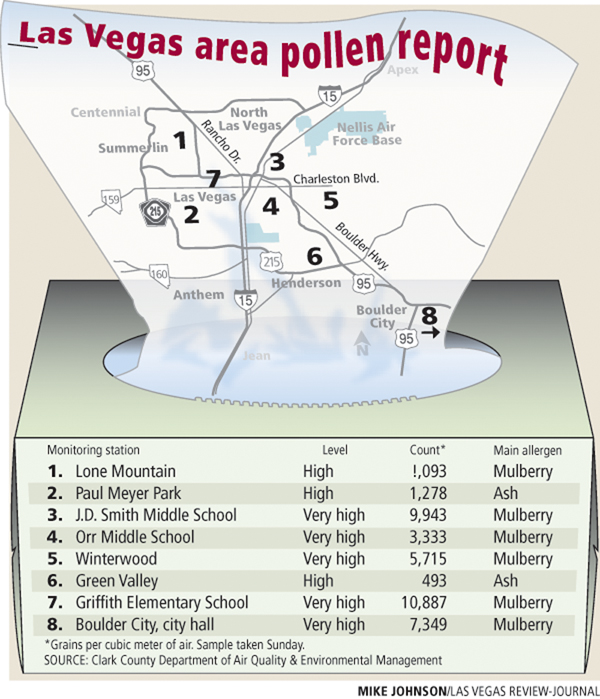Achoo! Mulberry woes in Valley nothing to sneeze at
The first day of spring arrives Friday and high levels of airborne allergens are making sure it's coming with gusto.
The fruitless mulberry tree is the biggest offender these days. Pollen counts reached more than 10,000 grains per cubic meter Tuesday in some parts of the Las Vegas Valley.
"It's that time of year," said Monte Symmonds, senior monitoring technician for the Clark County Department of Air Quality and Environmental Management.
The department considers mulberry levels higher than 1,500 grains per cubic meter to be "very high."
For allergy sufferers looking for the root of the problem, it's the mulberry's catkin, a yellowish part of the tree's bloom that gets taken airborne.
Measurements at the valley's eight monitoring stations indicate mulberry tree pollen is on the rise, with levels averaging 6,000 grains of pollen per cubic meter this time of year.
The highest level, 10,887 grains, was reported Tuesday at Griffith Elementary School, near Meadows Mall. The counts, though high, are right on target, Symmonds said.
"It's typical mulberry levels; it's what we expect to have every year," he said.
The mulberry tree, which is not indigenous to Southern Nevada, blooms between late February and early March. Shortly after, its catkin sprouts and gets scattered by the wind.
"Dr. Mulberry is a very good referring physician,'' Dr. Joram Seggev, a Las Vegas board certified allergist and immunologist, said about the number of patients streaming in and out of his office with runny noses and irritated eyes.
Seggev, along with Dr. Jim Christensen, a Las Vegas internal medicine and allergy specialist, said the allergy season actually began in mid-February with Arizona Ash tree pollutants.
Since mid-February both physicians have been treating patients for common allergy ailments. The number of patients being treated has increased in recent weeks because of mulberry pollen.
During the spring, summer and fall, pollen grains released from trees, weeds and grass hitch rides on air currents and can enter nostrils. Once inside, they trigger sneezing, runny or clogged noses, coughing, and itchy or watery eyes.
People who don't normally have allergies also may have symptoms, health officials say.
Pollen allergies also worsen asthma conditions, Seggev said. "Some of my patients only have asthma during the allergy season. I had three such patients today (Tuesday) and their stories are typical. One is asthmatic March through August and the others February till May. It all depends on what's blossoming."
In Southern Nevada, pollen concentrations from mulberry and olive trees are typically highest in March, April and May. After mulberry season ends, olive season begins.
For people already fighting allergy symptoms, Christensen and Seggev said over-the-counter allergy drugs are safe.
"Most of them you take at bedtime because they have a sedative side effect,'' Christensen said. "People should also remember to go to their doctor if the symptoms become problematic. There are a number of things we can do.''
Seggev said two over-the-counter antihistamines have fewer sedative effects.
Loratadine, commonly known as Claritin, is a non-sedative and can be bought at most drug stores as well as Target and Costco, Seggev said.
Cetirizine, commonly known as Zyrtec, is somewhat sedating but not as much as other over-the-counter drugs.
Seggev says some over-the-counter allergy drugs act as decongestants as well. People should take precautions when using those drugs because they can cause them to become jittery or raise their blood pressure.
"If you are young and otherwise healthy, you probably won't have a problem," Seggev said. "But, if you are older and have hypertension or a thyroid disease, you should not take those medications because they may worsen your disease."
Christensen said there are some common things people can do to avoid allergy symptoms, such as closing doors and windows and changing air filters on a regular basis.
Nevadans also should consider changing their exercise routines from the early mornings to afternoons, Christensen said. "Pollen levels are usually highest just before dawn and the early morning,'' he said.
Although it often is hard to forecast pollen levels, a lot depends on the weather.
"If we have a fairly normal spring with the usual temperatures then the pollution will be around longer, probably the end of May to mid-June'' Seggev said. "If early May is extremely hot, it may shorten the allergy season. Everything depends on the weather."
Symmonds offered a small measure of hope to allergy sufferers reaching for tissues "It's only once a year," he joked.
Contact reporter Maggie Lillis at mlillis@reviewjournal.com or 702-383-0279. Contact reporter Annette Wells at awells@reviewjournal.com at 702-383-0283.



















